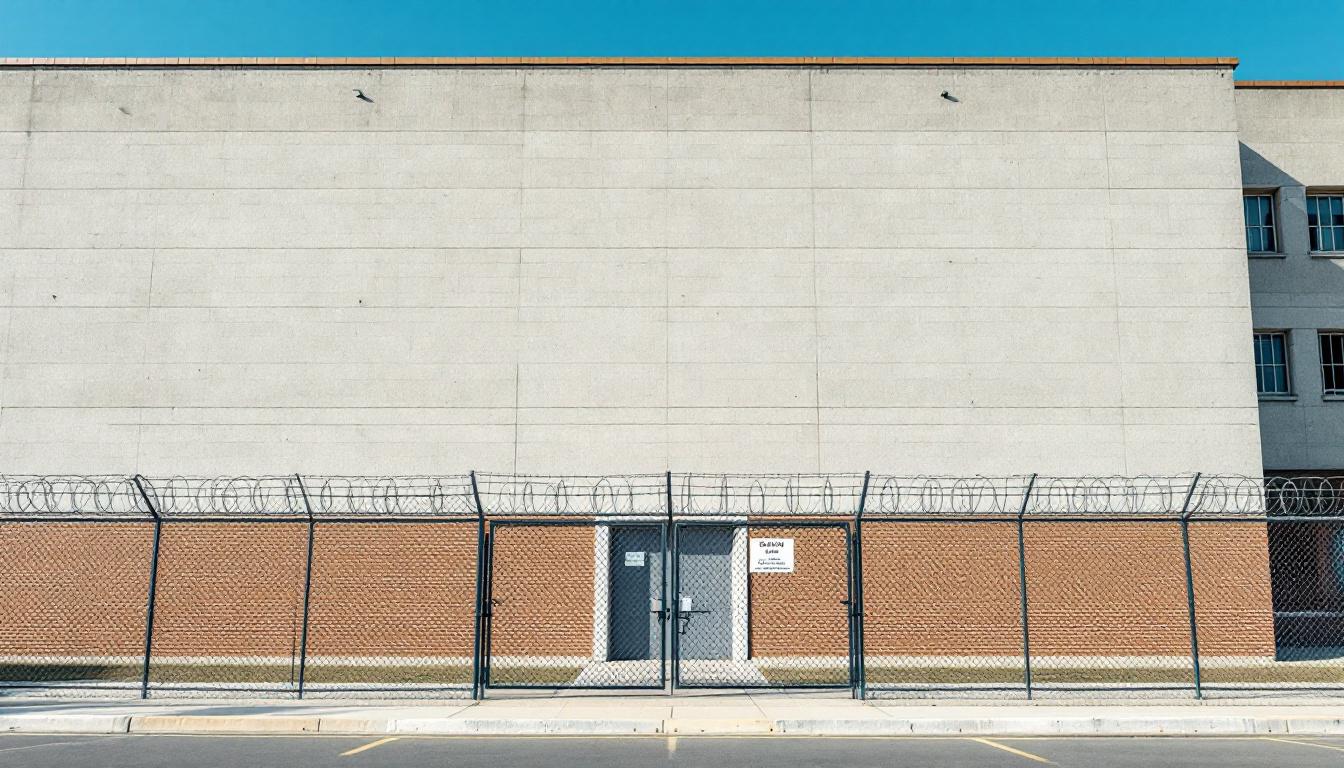
Quick Navigation
How to contact an inmate at Kent County Jail
This comprehensive guide will walk you through how to connect with an inmate at Kent County Jail. Follow the steps below to find an inmate and send letters and photos:
- Search for the inmate using our search tool below
- Create your account or log in to Penmate
- Write your message (up to 6,000 characters)
- Send instantly - inmates receive printed copies daily
Find an Inmate
Search for an inmate to start communicating today
Tip: You can search by first name, last name, or inmate ID number
To contact a person at Kent County Jail start by searching for the person on the official facility website. Perform a search by following these steps:
- Step 1: Enter their first name and last name into the search form and click "Search"
- Step 2: Locate their inmate record
- Step 3: Write down their Inmate ID and any housing information provided
Important! Be sure to enter the person's full name. Nicknames should not be used.
How to Send Messages to Inmates

You can use your phone or computer to send emails, letters, and photos to an inmate. Messages are sent electronically to inmate tablets or kiosks at the facility. If you would like to send a message, start by searching for an inmate at Kent County Jail.
Sending Photos and Postcards

A great way to send love and support to a loved one at Kent County Jail is to send photos and postcards. It only takes a few minutes to send photos from your phone and it makes a huge difference. You can also mail postcards with words of support and inspiration, or design your own postcard for special moments like birthdays and holidays.
Important! Be sure not to send any explicit photos or they may not be approved by the facility. You can also use a photo printing app like Penmate to make sure your photos are printed at the correct size (4x6 or 3x5) and are mailed according to the rules and regulations of Kent County Jail.
Frequently asked questions about Kent County Jail
-
How long does it take to deliver a message?
If you're sending an email message your letter is usually delivered within 24-48 hours. For messages sent via mail you should expect delivery within 3-7 days. All messages will need be approved by Kent County Jail.
-
How much does it cost to send a message to Kent County Jail?
You can send a message free using your phone or mail a message via USPS for the price of a $0.60 stamp and envelope. You can also purchase credits or e-stamps from services starting at $1.99.
-
What services can I use to contact an inmate at Kent County Jail?
Penmate
You can use Penmate to send letters and photos to an inmate from your phone. It's an easy way to stay in touch during your loved one's incarceration. Use the inmate locator to find an inmate's location and contact information, then you can send messages within a few minutes.
Securus messaging
Securus may be another option for communicating with an inmate at Kent County Jail. You can create a friends and family account and purchase credits to send messages. All messages will be reviewed and must be approved by the facility.
JPay
Some county jails and state prisons may support sending messages with JPay. You must register an account with the system, find your loved one, and purchase stamps to send messages. For some locations you can also attach photos.
Smart Jail Mail
You may also check if Smart Jail Mail is available at Kent County Jail. Smart Jail Mail is operated by Smart Communications and has contracted with some state and county jails. After purchasing credits, your messages and photos are sent to the facility, printed out, and then handed out to your loved one.
-
What is the mailing address of Kent County Jail?
Mailing address:
Kent County Jail
703 Ball Ave NE
Grand Rapids, MI 49503
Phone: (616) 632-6300Business hours:
- Monday: Open 24 hours
- Tuesday: Open 24 hours
- Wednesday: Open 24 hours
- Thursday: Open 24 hours
- Friday: Open 24 hours
- Saturday: Open 24 hours
- Sunday: Open 24 hours
-
What are the visiting hours at Kent County Jail?
Visiting hours at Kent County Jail vary by housing unit and security level. Generally, visits are scheduled on weekends and holidays, with some facilities offering weekday visits. Contact the facility directly at (616) 632-6300 or check their website for the current visiting schedule. Visits typically last 30-60 minutes and must be scheduled in advance.
-
What items are prohibited when sending mail to Kent County Jail?
Prohibited items typically include: cash, personal checks, stamps, stickers, glitter, glue, tape, staples, paperclips, polaroid photos, musical or blank greeting cards, hardcover books, magazines with staples, and any items containing metal or electronics. Only send letters on plain white paper with blue or black ink. Photos must be printed on regular photo paper (no Polaroids). Always check with Kent County Jail for their specific mail policies.
-
How do I send money to an inmate at Kent County Jail?
You can send money to an inmate at Kent County Jail through several methods: 1) Online using JPay, Access Corrections, or the facility's approved vendor, 2) Money orders mailed directly to the facility with the inmate's name and ID number, 3) Kiosks located in the facility lobby, or 4) Over the phone using a credit or debit card. Fees vary by method, typically ranging from $2.95 to $11.95 per transaction.
-
Can I schedule a video visit with an inmate at Kent County Jail?
Many facilities now offer video visitation as an alternative to in-person visits. At Kent County Jail, video visits may be available through services like Penmate, Securus Video Connect, GTL, or ICSolutions. Video visits typically cost $10-20 for 20-30 minutes and must be scheduled in advance. You'll need a computer or smartphone with a camera and reliable internet connection. Contact the facility for their specific video visitation policies and approved vendors.
-
What identification do I need to visit an inmate at Kent County Jail?
All visitors must present valid government-issued photo identification such as a driver's license, state ID, passport, or military ID. Minors must be accompanied by a parent or legal guardian who can provide the minor's birth certificate. Some facilities require visitors to be on the inmate's approved visitation list, which may require a background check. Contact Kent County Jail for specific ID requirements and visitor approval procedures.
-
How can I find out an inmate's release date?
To find an inmate's release date at Kent County Jail, you can: 1) Use the online inmate search tool if available, 2) Call the facility's records department, 3) Contact the inmate's case manager or counselor, or 4) Have the inmate provide this information during a call or visit. For privacy reasons, some facilities only release this information to immediate family members.
Facility Overview
Official Website

About Kent County Jail
Nestled within the heart of Grand Rapids, Michigan's urban landscape, Kent County Jail, MI serves as a cornerstone facility in the state's broader correctional network, emphasizing comprehensive support services that extend far beyond traditional detention. This MI correctional facility operates with a community-centered philosophy, recognizing that effective rehabilitation requires strong partnerships with local organizations, educational institutions, and social service providers throughout the greater Grand Rapids area. The facility's approach typically integrates multiple pathways for personal development, connecting residents with resources that may include vocational training opportunities, substance abuse counseling, and mental health support programs designed to address the underlying factors that often contribute to incarceration.
Programs within the facility generally focus on preparing individuals for successful reintegration into the Midwest community they will rejoin upon release. Educational initiatives may encompass basic literacy development, GED preparation, and job readiness training that aligns with employment opportunities available in the Grand Rapids metropolitan region. The county jail often collaborates with community partners to provide residents services that bridge the gap between incarceration and community life, potentially including family reunification support, housing assistance coordination, and connections to ongoing treatment resources. Through this holistic rehabilitation model, the facility aims to reduce recidivism while strengthening the broader social fabric of Kent County and surrounding areas.
Programs & Services
Educational pathways and therapeutic interventions form the cornerstone of rehabilitation efforts within Kent County Jail, where residents may access a comprehensive range of initiatives designed to address both immediate needs and long-term success. The facility's approach typically emphasizes skill-building and personal development through evidence-based programming. These initiatives often focus on breaking cycles of recidivism by providing residents with practical tools and knowledge they can apply upon release.
Vocational education opportunities may deliver hands-on training in trades such as carpentry, allowing residents to develop marketable skills while serving their sentences. Educational programs often include basic literacy instruction, GED preparation, and life skills courses that address fundamental knowledge gaps. Additionally, these academic initiatives typically provide structured learning environments where residents can work toward educational milestones at their own pace, building confidence alongside practical knowledge.
Support services and therapeutic initiatives may offer crucial assistance for residents facing substance abuse challenges and reentry concerns. Substance abuse treatment programs often include both group and individual counseling sessions designed to address underlying addiction issues. The prisoner reentry initiative typically provides residents with practical guidance on securing employment, housing, and community resources upon release. Additionally, life coaching and stress management initiatives may deliver coping strategies and emotional regulation techniques that residents can utilize both during incarceration and in their daily lives after release.
Daily Life & Visitation

Structured schedules currently anchor each day at Kent County Jail, creating predictable rhythms that residents can rely on. Morning routines typically begin early with wake-up calls, followed by cell inspections and headcounts that continue throughout the day at regular intervals. Meal times generally occur at consistent hours, delivering stability through their regularity. Work assignments may include kitchen duties, laundry services, or facility maintenance tasks that help residents stay productive. Additionally, programming schedules often incorporate educational opportunities, substance abuse counseling, and life skills workshops designed to support personal development.
Housing arrangements typically place residents in dormitory-style units or individual cells, depending on classification levels and available space. Living areas usually include basic furnishings such as beds, storage areas, and shared bathroom facilities. While personal property remains limited, residents can generally access commissary services to purchase approved items like hygiene products, snacks, and writing materials. The facility continues to maintain security protocols that include regular searches and movement restrictions between housing areas.
Recreation opportunities may deliver physical activity through scheduled gym time or outdoor recreation periods when weather permits. Additionally, residents often have access to television viewing areas, library services, and religious programming that can provide mental stimulation and spiritual support. Visitation policies typically allow family members to maintain contact through scheduled visits, while phone privileges and mail services continue to serve as important communication links. These connections often prove essential for maintaining family relationships and preparing for eventual reintegration into the community.
Ready to Connect?
Start communicating with your loved one today
Search for an Inmate









